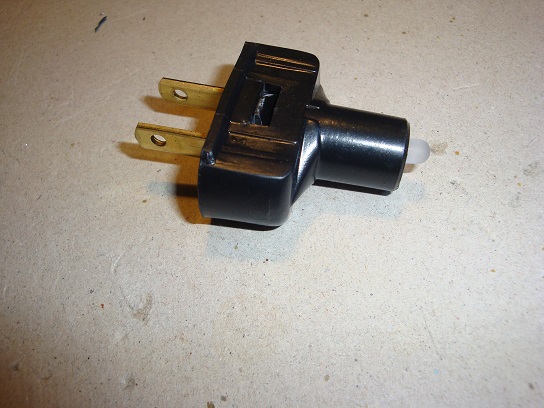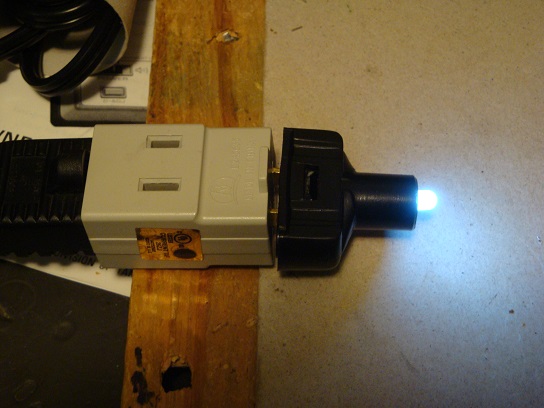The parts list changed recently because when I started this project
the LEDs were more robust and could take a higher reverse voltage. Which allowed
me to use a 104 - 334 (100 - 330 pf) capacitor and not the resistor.
There may be another way to reduce the power used at the expense of using more
parts. I will eventually try this way and put up that schematic and power usage
value after I test the next design thoroughly.
With this method you can use an even higher resitor, >100 KΩ, to make the
night light even less bright. I would not recommend using a resistor of less than
47 KΩ. While this will make it even brighter the night light plug gets
noticablly warm. Brighter LED, shorter LED life, higher voltage, higher current
so the resistor has to be higher wattage and it dissipates more heat, and this
is all wasted energy in my optinion and that brightness is not really needed.
Even when I used a 47 KΩ resistor my YF, who's night vision is worse than
mine, told me the night light was too bright. On the other hand, one of our grand
children likes this brighter night light.
 The LED, 47 KΩ Resistor, and the 1N4003 Diode.
The new design uses 1.2 mA of AC current for a power usage of about 144mW.
120 V * 0.0012 A = 0.144 Watts. or 144 mW
or at about 125 VAC ~150mW
The non-polarized AC replacement plug I used can be seen in the photos below.
I originally found these at ACE Hardware but during the 2019-2020 SARS CoV-2
Corona Virus Covid-19 pandemic I bought these through Amazon. I liked
this particular design because it had enough room for all the parts used
and the neck was the perfect place for the LED to stick out of with no way for
small fingers to get inside. If you're still worried about small fingers or
probes getting into the plug all bare wires can be covered with some kind of
brush on or dip-in rubber, or the hole can be sealed with electrically safe RTV.
The Ultra-Bright white LED can be salvaged from any number of items, a dead
LED AC bulb, solar walk-light, or flashlight are places I've gotten mine from.
The LED, 47 KΩ Resistor, and the 1N4003 Diode.
The new design uses 1.2 mA of AC current for a power usage of about 144mW.
120 V * 0.0012 A = 0.144 Watts. or 144 mW
or at about 125 VAC ~150mW
The non-polarized AC replacement plug I used can be seen in the photos below.
I originally found these at ACE Hardware but during the 2019-2020 SARS CoV-2
Corona Virus Covid-19 pandemic I bought these through Amazon. I liked
this particular design because it had enough room for all the parts used
and the neck was the perfect place for the LED to stick out of with no way for
small fingers to get inside. If you're still worried about small fingers or
probes getting into the plug all bare wires can be covered with some kind of
brush on or dip-in rubber, or the hole can be sealed with electrically safe RTV.
The Ultra-Bright white LED can be salvaged from any number of items, a dead
LED AC bulb, solar walk-light, or flashlight are places I've gotten mine from.
|


 The Travler's Night Light - The resistor, diode, and LED can be seen.
The Travler's Night Light - The resistor, diode, and LED can be seen.
 The Travler's Night Light - The resistor and LED can be seen.
The diode is a bit hidden inside the heat shrink tubing.
The Travler's Night Light - The resistor and LED can be seen.
The diode is a bit hidden inside the heat shrink tubing.
 The Traveler's Night Light completed inside the non-polarized plug.
The Traveler's Night Light completed inside the non-polarized plug.
 The Traveler's Night Light plugged into an AC extension cord.
The Traveler's Night Light plugged into an AC extension cord.